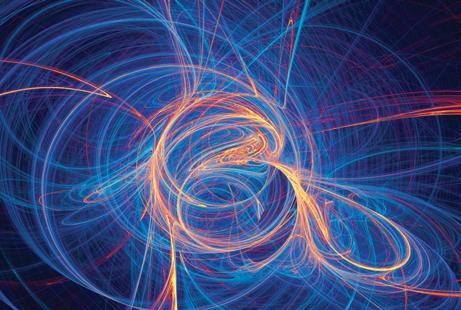
10 minute read
2 inside the Atom
Modern physics is built on two outstandingly successful theories, quantum theory and general relativity. Quantum theory describes phenomena on an atomic and subatomic scale. It has been tested to extraordinary levels of precision. For example, electrons have a magnetic property due to their spin, called the magnetic moment. Quantum theory predicts its value to be 1.001 159 652 181 13 (±8) (in certain units). Recent experimental measurements put this figure at 1.001 159 652 180 73 (±28). The precision is better than 1 part in a trillion (1012), like knowing the distance to the Moon to less than the thickness of a human hair.
General relativity is used to explain behaviour on an astronomical scale. It also has been tested thoroughly and has come through unscathed (Figure 1). The theory, which predicts that clocks will run slower in a stronger gravitational field, is essential to the accuracy of navigation using the GPS system.
The most likely candidate for a unified ‘Theory of Everything’ is string theory (Figure 2). This mathematical theory has succeeded in explaining many of the phenomena observed by particle physicists. However, it does not make any unique new predictions that can be tested by experiment. This has led some to suggest that string theory is not science at all. Richard Feynman, the Nobel Physicist whose work on quantum theory described the interaction between electrons and light, said, “It doesn’t matter how beautiful your theory is, it doesn’t matter how smart you are. If it doesn’t agree with experiment, it’s wrong.” star will bend as it passes close to the Sun. The Sun’s own light makes this impossible to detect, except during a solar eclipse. Arthur Eddington photographed the 1919 eclipse from the west coast of Africa. He sent this message to the mathematician Bertrand Russell: “Einstein’s theory is completely confirmed. The predicted displacement was 1.72° and the observed 1.75° (±0.06” )



All attempts to unite the two theories have led to infinite (impossible) solutions to the calculations. No one has yet developed a successful quantum theory of gravity, which would unify quantum physics and general relativity.
You will be familiar with the nuclear atom and you probably know something about radioactivity. You should be aware of the forces between electric charges and know what the term potential difference means.
In this chapter, you will learn more detail about the model of the atom and how this model evolved. The four fundamental interactions will be introduced and you will learn more about nuclear decay.
2.1 Atomic structure
Before 1900, scientists considered the atom a fundamental particle – a particle without structure or constituent parts. A few suggested that there could be something inside the atom, which would help to explain atomic spectra (see Chapter 5), but nobody suspected that the atom itself could be taken apart. J. J. Thomson’s discovery of the electron changed that: he realised that the electron was a part of the atom that had torn away.
The electron
Physicists in the 19th century had two wonderful new pieces of technology: the vacuum pump and the induction coil. The vacuum pump could create a very low pressure in a glass tube. The induction coil could generate a large potential difference (voltage) across electrodes placed in the tube. This technology led to the demonstration of radio waves by Hertz, the transmission of wireless telegraph signals by Marconi, the discovery of X-rays by Röntgen and the discovery of the first subatomic particle, the electron, by Thomson at the Cavendish Laboratory in Cambridge.
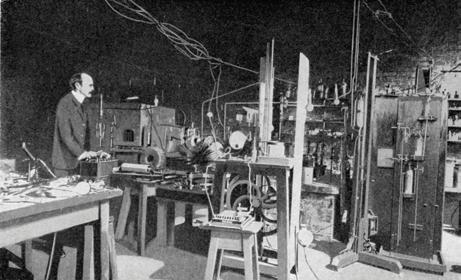
In Thomson’s ‘discharge tube’ (Figure 3b), a large potential difference was applied across two metal plates inside an evacuated glass tube. This caused a fluorescent glow from the tube.
Thomson was working on the hypothesis that cathode rays (Figure 4) were in fact a stream of electrically charged particles. He thought that these were emitted from the negatively charged plate (the cathode). A large potential difference accelerated particles; they travelled at high speed across the tube until they struck the glass, causing the glow. Thomson showed that he could deflect the beam with a magnet (Figure 5). He could also deflect the beam towards a positively charged plate. This proved that the cathode rays carried a negative electric charge.
Thomson’s balancing act
Thomson knew that the cathode rays were associated with negative charge, but to prove that they were a stream of identical particles he needed to show that they had a unique mass and charge. Initially Thomson could not find either of these quantities separately but he was able to measure the charge-to-mass ratio for the cathode rays. This ratio, sometimes called the specific charge, is written e/m where e is the charge carried by the electron and m is its mass. Specific charge is measured in coulombs per kilogram, C kg−1. A constant value of e/m would prove that cathode rays were in fact a stream of identical particles.
were the particle accelerators of their day. The fluorescence, first seen in the glass, became brighter with fluorescent coatings. This modern tube shows a metal object, a Maltese cross, casting a shadow by blocking the cathode rays.
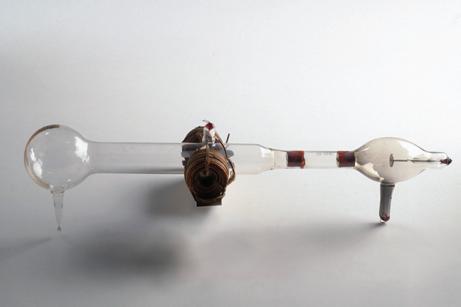
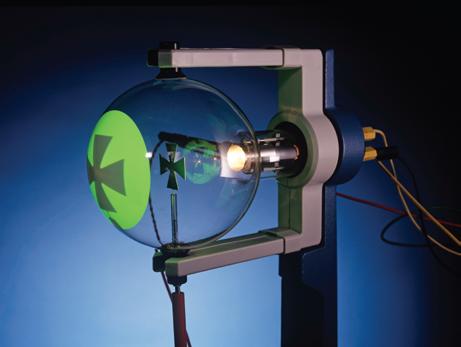
cathode (source of electrons) anode
+
Thomson used magnets to de ect the stream of cathode rays. to electrometer
Figure 5 Thomson’s experimental set-up pathway of unde ected stream of cathode rays
+ phosphorescent coating
Thomson did find a constant value, though he was surprised to find that it was 770 times larger than that of a hydrogen ion. Either the particles in the cathode rays carried a very large charge or they had a much smaller mass than an atom. Thomson opted for the latter.
“On this view we have in the cathode rays, matter in a new state, a state in which the subdivision of matter is carried very much further.”
Thomson was able to find e/m using crossed electric and magnetic fields. His apparatus had electric and magnetic fields arranged so that the deflections from each exactly cancelled out and so the cathode rays carried on in a straight line (Figure 6). By equating the forces from the two fields, Thomson was able to calculate a value for the specific charge of the electron (see Assignment 2).
Thomson then applied his method to the particles emitted by the photoelectric effect (see Chapter 5) and found that they had the same value for e/m as cathode rays. In 1899, Thomson concluded that cathode rays were “a splitting up of the atom, a part of the mass of the atom getting free and becoming detached from the original atom”. Thomson had discovered the electron.
I force lines go into the plane of the page.
(b) In a magnetic eld electrons are made to travel in a circular path The direction of the force at any instant can be predicted using Fleming’s left hand rule: ux eld force force force, F
(c) Thomson balanced the effects of the magnetic and electric elds so that the electron travelled in a straight line
+
Later experiments by Robert Millikan found a more accurate result for the charge on an electron. The currently accepted value is e = −1.602 176 57×10−19 coulombs. The specific charge of the electron is e/m = −1.758 820 088 (±39) × 1011 C kg−1. There is no evidence to suggest that the electron has any internal structure, or has any other constituents. It is still considered to be a fundamental particle.
3 2.1 Atomic structure 206092 AS Physics A-Level_Sample_CH 2.indd 3 9/29/14 6:13 PM
Cathode Rays
By J.J. THOMSON, M.A., F.R.S., Cavendish Professor of Experimental Physics, Cambridge.
The experiments discussed in this paper were undertaken in the hope of gaining some information as to the nature of cathode rays . . . According to the almost unanimous opinion of German physicists they are due to some process in the aether1 . . . another view of these rays is that . . . they are in fact wholly material, and that they mark the paths of particles of matter charged with negative electricity . . . The following experiments were carried out to test some of the consequences of the electrified-particle theory.
electrometer. I was surprised at the magnitude of the charge . . . Thus this experiment shows that however we twist and deflect the cathode rays by magnetic forces, the negative electrification follows the same path as the rays, and that this negative electrification is indissolubly connected with the cathode rays.
[Thomson goes on to discuss the effect of an electric field on cathode rays . . .]
Deflexion of the Cathode Rays by an Electrostatic Field
Electrometer
Two coaxial cylinders with slits in them are placed in a bulb connected with a discharge tube; the cathode rays . . . do not fall upon the cylinders unless they are deflected by a magnet. The outer cylinder is connected with the Earth, the inner with the electrometer. When the cathode rays (whose path was traced by the phosphorescence on the glass) did not fall on the slit, the electrical charge sent to the electrometer . . . was small and irregular; when, however, the rays were bent by a magnet so as to fall on the slit there was a large charge of negative electricity sent to the
The plum pudding atom
Physicists construct models that describe some aspect of the real world, such as the kinetic theory of gases, or the Big Bang model for the beginning of the Universe. Naturally, physicists began to suggest models for the atom.
A first thought (Thomson’s) was that atoms were made entirely of electrons. A hydrogen atom might consist of around 1000 electrons. However, there had to be some positive charge to cancel out the negative charge carried by all those electrons. This was necessary or else electrostatic repulsion would push apart the whole atom. How much mass did this positive charge have and where was it?
At high exhaustions (a strong vacuum or low pressure) the rays were deflected when the two aluminium plates were connected with the terminals of a battery of small storage-cells; the rays were depressed when the upper plate was connected with the negative pole of the battery, the lower with the positive, and raised when the upper plate was connected with the positive, the lower with the negative pole. The deflexion was proportional to the difference of potential between the plates, and I could detect the deflexion when the potential difference was as small as two volts. It was only when the vacuum was a good one that the deflexion took place.
Thomson’s plum pudding model (Figure 8) pictured the atom as a uniform, positively charged cloud with tiny electrons embedded in it, like plums in a pudding.
ASSignmEnT 1: UnDERSTAnDing THOmSOn’S ExpERimEnTS
J.J. Thomson was awarded the 1905 Nobel Prize for Physics “for his theoretical and experimental investigations on the conduction of electricity by gases”. Read the extract from J.J. Thomson’s paper Cathode Rays in Figure 7. You may need to do some brief internet searches to help you to answer the questions below.
Tasks
A1 In Thomson’s first experiment (detail shown in Figure 5), how were the cathode rays deflected? How could Thomson see what path they took? What did he use to detect the cathode rays?
A2 How did Thomson’s view of cathode rays differ from that of the ‘German physicists’ that he mentions?
A3 In the second experiment described by Thomson he says that a good vacuum (low pressure) is needed to see the cathode rays. What does this suggest about cathode rays?
A4 Thomson says that the deflection is proportional to the difference in the potential of the (horizontal) plates. What does this suggest about cathode rays?
A5 The Crookes tube apparatus had been around for at least 40 years before J. J. Thomson used a version of it to identify the electron. Why did it take so long?
The term ‘pudding’ is rather misleading; the low density of the positive part of the atom makes it more like a cloud than a pudding.
2.2 the discovery of the nucleus
The first steps in nuclear physics were taken early in 1909. Hans Geiger and his research student Ernest Marsden were conducting an experiment to investigate the scattering of alpha particles as they collided with gold atoms (Figure 9). The experiment was overseen by Ernest Rutherford. He had shown (see section 2.4) that an alpha particle is a tightly bound group of two neutrons and two protons – a helium nucleus – that is emitted at high velocity from some radioactive isotopes.
The plum pudding model had problems though. An atom with stationary electrons cannot be stable, so the electrons must be moving around. Yet, whenever a charged particle accelerates, including any change of direction, it emits electromagnetic radiation. So, electrons moving around in the atom would radiate energy and slow down. Sooner or later, all atoms would become unstable. The fate of the plum pudding model was finally decided by experiments carried out at Manchester University in 1909.
KEY iDEAS
› The electron is a fundamental particle.
› The electron has a mass of 9.1×10−31 kg and carries a negative charge of 1.6×10−19 C.
› The charge – mass ratio, or specific charge, is very high for the electron, e/m= −1.758 820 088 (±39)×1011 C kg−1
› The plum pudding model represented atoms as tiny electrons embedded in a positively charged background of uniform density.
Geiger and Marsden used radium as the source of the alpha particles, which were beamed towards a thin gold foil. The alpha particles, after passing through the foil, hit a zinc sulfide screen. When each particle hit the screen there
ASSignmEnT 2: mEASURing THE SpECifiC CHARgE ( e/m ) Of THE ElECTROn
It is possible to carry out or observe a modern version of Thomson’s experiment, using the apparatus in Figure A1. If you are not able to see this first-hand, there are simulations on the internet. Your aim in this assignment is to understand how the apparatus works and to get a value for e/m, known as the specific charge.
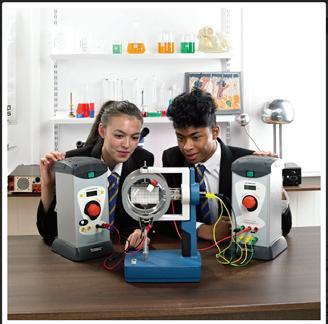
You should be able to vary three independent factors:
• The accelerating voltage, Va. Increasing this makes the electrons travel faster (see Figure A2).
• The deflecting voltage, Vd . Increasing this voltage increases the force on the electron as it passes between the plates.





